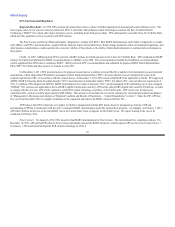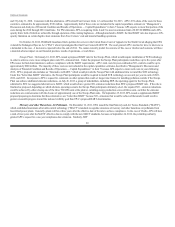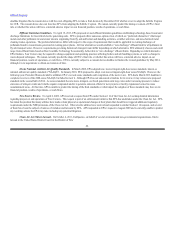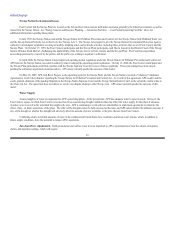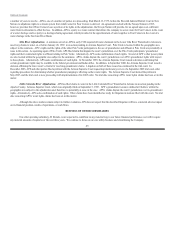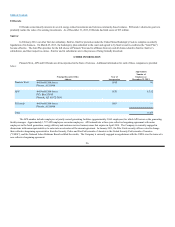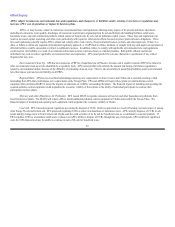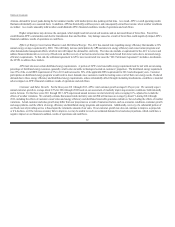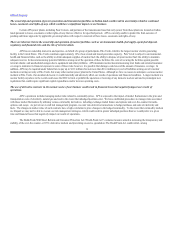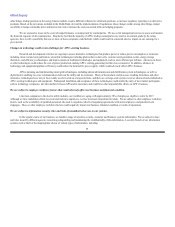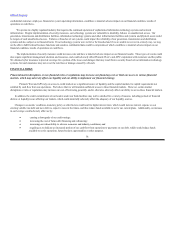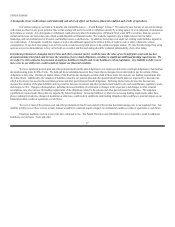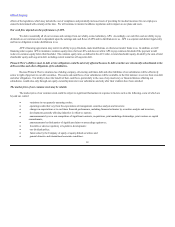APS 2013 Annual Report Download - page 31
Download and view the complete annual report
Please find page 31 of the 2013 APS annual report below. You can navigate through the pages in the report by either clicking on the pages listed below, or by using the keyword search tool below to find specific information within the annual report.
Table of Contents
APS’s ability to conduct its business operations and avoid fines and penalties depends upon compliance with federal, state or local statutes,
regulations and ACC requirements, and obtaining and maintaining certain regulatory permits, approvals and certificates.
APS must comply in good faith with all applicable statutes, regulations, rules, tariffs, and orders of agencies that regulate APS’s business,
including FERC, NRC, EPA, the ACC and state and local governmental agencies. These agencies regulate many aspects of APS’s utility operations,
including safety and performance, emissions, siting and construction of facilities, customer service and the rates that APS can charge retail and wholesale
customers. Failure to comply can subject APS to, among other things, fines and penalties. For example, under the Energy Policy Act of 2005, FERC can
impose penalties (up to one million dollars per day per violation) for failure to comply with mandatory electric reliability standards. APS is also required to
have numerous permits, approvals and certificates from these agencies. APS believes the necessary permits, approvals and certificates have been obtained for
its existing operations and that APS’s business is conducted in accordance with applicable laws in all material respects. However, changes in regulations or
the imposition of new or revised laws or regulations could have an adverse impact on our results of operations. We are also unable to predict the impact on our
business and operating results from pending or future regulatory activities of any of these agencies .
The operation of APS’s nuclear power plant exposes it to substantial regulatory oversight and potentially significant liabilities and capital
expenditures.
The NRC has broad authority under federal law to impose safety-related, security-related and other licensing requirements for the operation of nuclear
generation facilities. Events at nuclear facilities of other operators or impacting the industry generally may lead the NRC to impose additional requirements
and regulations on all nuclear generation facilities, including Palo Verde. As a result of the March 2011 earthquake and tsunamis that caused significant
damage to the Fukushima Daiichi Nuclear Power Plant in Japan, various industry organizations are working to analyze information from the Japan incident
and develop action plans for U.S. nuclear power plants. Additionally, the NRC has been performing its own independent review of the events at Fukushima
Daiichi, including a review of the agency’s processes and regulations in order to determine whether the agency should promulgate additional regulations and
possibly make more fundamental changes to the NRC’s system of regulation. We cannot predict when or if the NRC will complete its formal actions as a
result of its review. As a result of the Fukushima event, however, the NRC has directed nuclear power plants to implement the first tier recommendations of
the NRC’s Near Term Task Force. In response to these recommendations, Palo Verde expects to spend approximately $100 million for capital enhancements to
the plant over the next several years (APS’s share is 29.1%). We cannot predict whether these amounts will increase or whether additional financial and/or
operational requirements on Palo Verde and APS may be imposed.
In the event of noncompliance with its requirements, the NRC has the authority to impose a progressively increased inspection regime that could
ultimately result in the shut-down of a unit or civil penalties, or both, depending upon the NRC’s assessment of the severity of the situation, until compliance
is achieved. The increased costs resulting from penalties, a heightened level of scrutiny and implementation of plans to achieve compliance with NRC
requirements may adversely affect APS’s financial condition, results of operations and cash flows.
28



